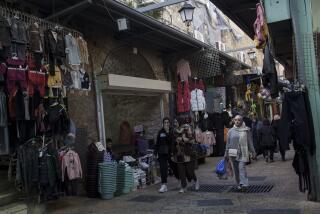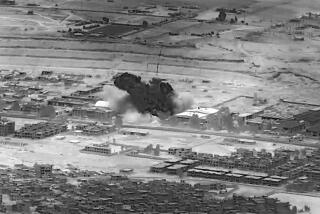Iraqi Holy Sites Become Domes of Contention
NAJAF, Iraq — At the center of the deadly conflict in southern Iraq between U.S. forces and anti-American cleric Muqtada Sadr stand two large mosques.
Sunlight reflected off the mosques’ golden domes is visible from most of the streets, small farms and ancient cemeteries of Najaf and Kufa, sister cities 100 miles south of Baghdad.
All involved in the conflict agree that the mosques are important, but for very different reasons. To Iraq’s Shiite Muslim majority, the mosques are holy. To Sadr, they are a symbol of his power. To city residents, they are economic pillars. To the U.S.-led Coalition Provisional Authority, they are political hot buttons. And to the U.S. military, they are enemy refuges that it can’t attack for sensitivity reasons.
“This problem might be over, except for those mosques,” said Lt. Col. Pat White, commander of the U.S. military base between Najaf and Kufa. White said his troops were not permitted to patrol areas immediately surrounding the mosques, stymieing his ability to end attacks. “Eventually,” he said, “someone will have to deal with them.”
Control of the shrines and cities has become a key issue in battles within the Shiite community and between Sadr and U.S. forces. Sadr’s militia -- known as the Al Mahdi army -- moved into Najaf and Kufa in April, seizing police stations and religious buildings. Two U.S. soldiers, more than 100 insurgents believed affiliated with Sadr and an unknown number of civilians have been killed in the fighting.
The offensive was widely viewed as an attempt by Sadr to strengthen his power by seizing the Imam Ali shrine in Najaf and the Kufa mosque, two of Shiite Islam’s holiest sites. Imam Ali, son-in-law of the prophet Muhammad and revered by Shiites as his true heir, reportedly is buried at the Najaf shrine. He was killed at the entrance to the Kufa mosque more than 1,000 years ago by extremist followers who had turned against him.
The Shiite community in Iraq is divided between outspoken, anti-American leaders such as Sadr and less vocal figures such as Grand Ayatollah Ali Sistani.
“Possession of those mosques puts Sadr in a powerful position,” said Staff Sgt. Timothy Corbin, a U.S. intelligence officer based outside Najaf. “Control could give him influence over Sistani and other Shiite leaders who depend on those symbols as sources of authority and part of how they communicate with Shiites worldwide.”
Coalition forces have cultivated a relationship with Sistani, seeking his approval for the interim government that will take over when the U.S. transfers sovereignty June 30. They have also tried to marginalize Sadr -- an outspoken critic of Sistani.
One reason for the United States’ insistence on Sadr’s withdrawal from the mosques may be to deny him their symbolic significance and undermine his political image.
Sadr’s control of the sites expands his pulpits and profile beyond Sadr City, the impoverished Baghdad neighborhood named for his assassinated father, and is a potent signal of his might. Sadr’s supporters have become more vocal, shouting down other imams when they have been critical of Sadr in Friday sermons, and have increased attacks on U.S. patrols in Sadr City.
The constant gun battles he has brought to the cities have turned inhabitants against him.
“Sadr’s army are terrorists,” Najaf resident Karam Hamza said. “My daughter was shot in the arm when they fought the Americans. We only want Sadr to leave.”
Others are offended by the militia’s use of the mosques as sanctuaries. Gunmen stream out of the two mosques when Americans approach, guided by a loudspeaker mounted on the mosque’s towers. A 50-caliber machine gun sits in the Kufa mosque minaret, and the blue domes of surrounding mosques hide antiaircraft weapons, insurgents and mortar caches, the U.S. military says.
Much local discontent is economic. A steady stream of Shiite pilgrims traveled to Najaf and Kufa before fighting began in April. “It was one of the few cities in Iraq that was economically strong,” said a coalition spokesman in Najaf who spoke on the condition of anonymity. “Pilgrims brought in hundreds of millions of dollars every year.”
With the standoff, tourism has ground to a halt.
“Sadr says he is for me, but my children are starving because pilgrims cannot come to the shrine,” said Hadi Nijim, who sells religious icons but has bricked up his windows and door.
The local population appears to support the U.S. presence. Children and adults rush out when tanks and armored vehicles roll through town, giving troops thumbs-up signs. Patrols through the cities in the last two weeks have been attacked only near the two mosques, the military says.
Those attacks, however, occur daily, and regional commanders say that denying insurgents use of the mosques is essential to end the insurrection.
“If I go into Kufa’s mosque, I’ll find an arms factory in there,” Lt. Col. White said. “But our orders are not to fire at them.”
Iraqi leaders have criticized the military for mounting “aggressive” patrols near the mosques. White acknowledges that his strategy has been to send U.S. forces near the mosques to draw enemy fire, giving his soldiers an opportunity to “kill the bad guys when they come out.” Soldiers do not fire on people who are not carrying visible weapons, he said.
“If this thing doesn’t end through a treaty, eventually we will have to attack that mosque,” White said. “But that’s a political decision.” Commanders say that if the mosque were to be attacked, U.S. forces probably would escort Iraqi security forces to the mosques’ gates, and not move inside themselves.
The coalition authority is eager to find a noncombat solution before June 30. Coalition and military representatives have emphasized that they believed any attacks on the mosques would inflame Muslim anger against Americans.
Two weeks ago, coalition representatives accepted a peace overture in which Sadr’s militia would disarm and a warrant for Sadr’s arrest -- which precipitated the standoff -- would be suspended. Military officers suspended operations as coalition officials continued negotiations to revive the lapsed truce, and the Najaf governor has asked Iraqi police to take over security patrols in the city.
“We want everything stable before June 30,” said a coalition official who requested anonymity. “We’ll do what it takes to get it, as long as there isn’t a security void in Najaf.”
Military leaders, however, say such a strategy is unwise.
“The Iraqi forces in Najaf aren’t ready to take over,” White said. “Appeasement isn’t going to work in the long run.”
Even if the Al Mahdi army did disarm, as a deal reached Friday mandates, it is unclear who would control the mosques after June 30, and how Sadr and his forces would be prevented from launching attacks.
“If the fighters bury their guns in the sand and come back in two months, they’ll be able to take the mosques right back,” said a coalition official who spoke on condition of anonymity.
One possibility under discussion among coalition and Shiite leaders is giving Sadr or his deputies a seat on a high-level advisory body that may be established after June 30. Another possibility is integrating his militia with Najaf and Kufa security forces.
“After June 30, everything changes,” another coalition official said. “It’s worth remembering that Imam Ali wasn’t killed by his enemies -- he was killed by supposed supporters. Who knows if Sadr is driving this, or if it is being driven by the militants? We’ll just work to establish security before we leave.”
More to Read
Sign up for Essential California
The most important California stories and recommendations in your inbox every morning.
You may occasionally receive promotional content from the Los Angeles Times.









